Running an Experiment
This guide describes how to configure and run a Katib experiment. The experiment can perform hyperparameter tuning or a neural architecture search (NAS) (alpha), depending on the configuration settings.
For an overview of the concepts involved, check the introduction to Katib.
Packaging your training code in a container image
Katib and Kubeflow are Kubernetes-based systems. To use Katib, you must package your training code in a Docker container image and make the image available in a registry. Check the Docker documentation and the Kubernetes documentation.
Configuring the experiment
To create a hyperparameter tuning or NAS experiment in Katib, you define the experiment in a YAML configuration file. The YAML file defines the range of potential values (the search space) for the parameters that you want to optimize, the objective metric to use when determining optimal values, the search algorithm to use during optimization, and other configurations.
As a reference, you can use the YAML file of the random search algorithm example.
The list below describes the fields in the YAML file for an experiment. The Katib UI offers the corresponding fields. You can choose to configure and run the experiment from the UI or from the command line.
Configuration spec
These are the fields in the experiment configuration spec:
-
parameters: The range of the hyperparameters or other parameters that you want to tune for your machine learning (ML) model. The parameters define the search space, also known as the feasible set or the solution space. In this section of the spec, you define the name and the distribution (discrete or continuous) of every hyperparameter that you need to search. For example, you may provide a minimum and maximum value or a list of allowed values for each hyperparameter. Katib generates hyperparameter combinations in the range based on the hyperparameter tuning algorithm that you specify. Refer to the
ParameterSpectype. -
objective: The metric that you want to optimize. The objective metric is also called the target variable. A common metric is the model’s accuracy in the validation pass of the training job (validation-accuracy). You also specify whether you want Katib to maximize or minimize the metric.
Katib uses the
objectiveMetricNameandadditionalMetricNamesto monitor how the hyperparameters work with the model. Katib records the value of the bestobjectiveMetricNamemetric (maximized or minimized based ontype) and the corresponding hyperparameter set in the experiment’s.status.currentOptimalTrial.parameterAssignments. If theobjectiveMetricNamemetric for a set of hyperparameters reaches thegoal, Katib stops trying more hyperparameter combinations.You can run the experiment without specifying the
goal. In that case, Katib runs the experiment until the corresponding successful trials reachmaxTrialCount.maxTrialCountparameter is described below.The default way to calculate the experiment’s objective is:
-
When the objective
typeismaximize, Katib compares all maximum metric values. -
When the objective
typeisminimize, Katib compares all minimum metric values.
To change the default settings, define
metricStrategieswith various rules (min,maxorlatest) to extract values for each metric from the experiment’sobjectiveMetricNameandadditionalMetricNames. The experiment’s objective value is calculated in accordance with the selected strategy.For example, you can set the parameters in your experiment as follows:
. . . objectiveMetricName: accuracy type: maximize metricStrategies: - name: accuracy value: latest . . .where the Katib controller is searching for the best maximum from the all latest reported
accuracymetrics for each trial. Check the metrics strategies example. The default strategy type for each metric is equal to the objectivetype.Refer to the
ObjectiveSpectype. -
-
parallelTrialCount: The maximum number of hyperparameter sets that Katib should train in parallel. The default value is 3.
-
maxTrialCount: The maximum number of trials to run. This is equivalent to the number of hyperparameter sets that Katib should generate to test the model. If the
maxTrialCountvalue is omitted, your experiment will be running until the objective goal is reached or the experiment reaches a maximum number of failed trials. -
maxFailedTrialCount: The maximum number of failed trials before Katib should stop the experiment. This is equivalent to the number of failed hyperparameter sets that Katib should test. If the number of failed trials exceeds
maxFailedTrialCount, Katib stops the experiment with a status ofFailed. -
algorithm: The search algorithm that you want Katib to use to find the best hyperparameters or neural architecture configuration. Examples include random search, grid search, Bayesian optimization, and more. Check the search algorithm details below.
-
trialTemplate: The template that defines the trial. You have to package your ML training code into a Docker image, as described above.
trialTemplate.trialSpecis your unstructured template with model parameters, which are substituted fromtrialTemplate.trialParameters. For example, your training container can receive hyperparameters as command-line arguments or as environment variables. You have to set the name of your training container intrialTemplate.primaryContainerName.Katib dynamically supports any kind of Kubernetes CRD. In Katib examples, you can find the following job types to train your model:
Refer to the
TrialTemplatetype. Follow the trial template guide to understand how to specifytrialTemplateparameters, save templates inConfigMapsand support custom Kubernetes resources in Katib. -
metricsCollectorSpec: A specification of how to collect the metrics from each trial, such as the accuracy and loss metrics. Learn the details of the metrics collector below. The default metrics collector is
StdOut. -
nasConfig: The configuration for a neural architecture search (NAS). Note: NAS is currently in alpha with limited support. You can specify the configurations of the neural network design that you want to optimize, including the number of layers in the network, the types of operations, and more. Refer to the
NasConfigtype.-
graphConfig: The graph config that defines structure for a directed acyclic graph of the neural network. You can specify the number of layers,
input_sizesfor the input layer andoutput_sizesfor the output layer. Refer to theGraphConfigtype. -
operations: The range of operations that you want to tune for your ML model. For each neural network layer the NAS algorithm selects one of the operations to build a neural network. Each operation contains sets of parameters which are described above. Refer to the
Operationtype.You can find all NAS examples here.
-
-
resumePolicy: The experiment resume policy. Can be one of
LongRunning,NeverorFromVolume. The default value isLongRunning. Refer to theResumePolicytype. To find out how to modify a running experiment and use various restart policies follow the resume an experiment guide.
Background information about Katib’s Experiment, Suggestion and Trial
type: In Kubernetes terminology, Katib’s
Experiment type,
Suggestion type and
Trial type
is a custom resource (CR).
The YAML file that you create for your experiment is the CR specification.
Search algorithms in detail
Katib currently supports several search algorithms.
Refer to the
AlgorithmSpec type.
Here’s a list of the search algorithms available in Katib:
- Grid search
- Random search
- Bayesian optimization
- Hyperband
- Tree of Parzen Estimators (TPE)
- Multivariate TPE
- Covariance Matrix Adaptation Evolution Strategy (CMA-ES)
- Sobol’s Quasirandom Sequence
- Neural Architecture Search based on ENAS
- Differentiable Architecture Search (DARTS)
More algorithms are under development.
You can add an algorithm to Katib yourself. Check the guide to adding a new algorithm and the developer guide.
Grid search
The algorithm name in Katib is grid.
Grid sampling is useful when all variables are discrete (as opposed to continuous) and the number of possibilities is low. A grid search performs an exhaustive combinatorial search over all possibilities, making the search process extremely long even for medium sized problems.
Katib uses the Chocolate optimization framework for its grid search.
Random search
The algorithm name in Katib is random.
Random sampling is an alternative to grid search and is used when the number of discrete variables to optimize is large and the time required for each evaluation is long. When all parameters are discrete, random search performs sampling without replacement. Random search is therefore the best algorithm to use when combinatorial exploration is not possible. If the number of continuous variables is high, you should use quasi random sampling instead.
Katib uses the Hyperopt, Goptuna, Chocolate or Optuna optimization framework for its random search.
Katib supports the following algorithm settings:
| Setting name | Description | Example |
|---|---|---|
| random_state | [int]: Set random_state to something other than None
for reproducible results. |
10 |
Bayesian optimization
The algorithm name in Katib is bayesianoptimization.
The Bayesian optimization method uses Gaussian process regression to model the search space. This technique calculates an estimate of the loss function and the uncertainty of that estimate at every point in the search space. The method is suitable when the number of dimensions in the search space is low. Since the method models both the expected loss and the uncertainty, the search algorithm converges in a few steps, making it a good choice when the time to complete the evaluation of a parameter configuration is long.
Katib uses the
Scikit-Optimize or
Chocolate optimization framework
for its Bayesian search. Scikit-Optimize is also known as skopt.
Katib supports the following algorithm settings:
| Setting Name | Description | Example |
|---|---|---|
| base_estimator | [“GP”, “RF”, “ET”, “GBRT” or sklearn regressor, default=“GP”]:
Should inherit from sklearn.base.RegressorMixin.
The predict method should have an optional
return_std argument, which returns
std(Y | x) along with E[Y | x]. If
base_estimator is one of
[“GP”, “RF”, “ET”, “GBRT”], the system uses a default surrogate model
of the corresponding type. Learn more information in the
skopt
documentation. |
GP |
| n_initial_points | [int, default=10]: Number of evaluations of func with
initialization points before approximating it with
base_estimator. Points provided as x0 count
as initialization points.
If len(x0) < n_initial_points, the
system samples additional points at random. Learn more information in the
skopt
documentation. |
10 |
| acq_func | [string, default="gp_hedge"]: The function to
minimize over the posterior distribution. Learn more information in the
skopt
documentation. |
gp_hedge |
| acq_optimizer | [string, “sampling” or “lbfgs”, default=“auto”]: The method to
minimize the acquisition function. The system updates the fit model
with the optimal value obtained by optimizing acq_func
with acq_optimizer. Learn more information in the
skopt
documentation. |
auto |
| random_state | [int]: Set random_state to something other than None
for reproducible results. |
10 |
Hyperband
The algorithm name in Katib is hyperband.
Katib supports the Hyperband optimization framework. Instead of using Bayesian optimization to select configurations, Hyperband focuses on early stopping as a strategy for optimizing resource allocation and thus for maximizing the number of configurations that it can evaluate. Hyperband also focuses on the speed of the search.
Tree of Parzen Estimators (TPE)
The algorithm name in Katib is tpe.
Katib uses the Hyperopt, Goptuna or Optuna optimization framework for its TPE search.
This method provides a forward and reverse gradient-based search.
Katib supports the following algorithm settings:
| Setting name | Description | Example |
|---|---|---|
| n_EI_candidates | [int]: Number of candidate samples used to calculate the expected improvement. | 25 |
| random_state | [int]: Set random_state to something other than None
for reproducible results. |
10 |
| gamma | [float]: The threshold to split between l(x) and g(x), check equation 2 in this Paper. Value must be in (0, 1) range. | 0.25 |
| prior_weight | [float]: Smoothing factor for counts, to avoid having 0 probability. Value must be > 0. | 1.1 |
Multivariate TPE
The algorithm name in Katib is multivariate-tpe.
Katib uses the Optuna optimization framework for its Multivariate TPE search.
Multivariate TPE is improved version of independent (default) TPE. This method finds dependencies among hyperparameters in search space.
Katib supports the following algorithm settings:
| Setting name | Description | Example |
|---|---|---|
| n_ei_candidates | [int]: Number of Trials used to calculate the expected improvement. | 25 |
| random_state | [int]: Set random_state to something other than None
for reproducible results. |
10 |
| n_startup_trials | [int]: Number of initial Trials for which the random search algorithm generates hyperparameters. | 5 |
Covariance Matrix Adaptation Evolution Strategy (CMA-ES)
The algorithm name in Katib is cmaes.
Katib uses the Goptuna or Optuna optimization framework for its CMA-ES search.
The Covariance Matrix Adaptation Evolution Strategy is a stochastic derivative-free numerical optimization algorithm for optimization problems in continuous search spaces. You can also use IPOP-CMA-ES and BIPOP-CMA-ES, variant algorithms for restarting optimization when converges to local minimum.
Katib supports the following algorithm settings:
| Setting name | Description | Example |
|---|---|---|
| random_state | [int]: Set random_state to something other than None
for reproducible results. |
10 |
| sigma | [float]: Initial standard deviation of CMA-ES. | 0.001 |
| restart_strategy | [string, "none", "ipop", or "bipop", default="none"]: Strategy for restarting CMA-ES optimization when converges to a local minimum. | "ipop" |
Sobol’s Quasirandom Sequence
The algorithm name in Katib is sobol.
Katib uses the Goptuna optimization framework for its Sobol’s quasirandom search.
The Sobol’s quasirandom sequence is a low-discrepancy sequence. And it is known that Sobol’s quasirandom sequence can provide better uniformity properties.
Neural Architecture Search based on ENAS
The algorithm name in Katib is enas.
Alpha version
Neural architecture search is currently in alpha with limited support. The Kubeflow team is interested in any feedback you may have, in particular with regards to usability of the feature. You can log issues and comments in the Katib issue tracker.This NAS algorithm is ENAS-based. Currently, it doesn’t support parameter sharing.
Katib supports the following algorithm settings:
| Setting Name | Type | Default value | Description |
|---|---|---|---|
| controller_hidden_size | int | 64 | RL controller lstm hidden size. Value must be >= 1. |
| controller_temperature | float | 5.0 | RL controller temperature for the sampling logits. Value must be > 0. Set value to "None" to disable it in the controller. |
| controller_tanh_const | float | 2.25 | RL controller tanh constant to prevent premature convergence. Value must be > 0. Set value to "None" to disable it in the controller. |
| controller_entropy_weight | float | 1e-5 | RL controller weight for entropy applying to reward. Value must be > 0. Set value to "None" to disable it in the controller. |
| controller_baseline_decay | float | 0.999 | RL controller baseline factor. Value must be > 0 and <= 1. |
| controller_learning_rate | float | 5e-5 | RL controller learning rate for Adam optimizer. Value must be > 0 and <= 1. |
| controller_skip_target | float | 0.4 | RL controller probability, which represents the prior belief of a skip connection being formed. Value must be > 0 and <= 1. |
| controller_skip_weight | float | 0.8 | RL controller weight of skip penalty loss. Value must be > 0. Set value to "None" to disable it in the controller. |
| controller_train_steps | int | 50 | Number of RL controller training steps after each candidate runs. Value must be >= 1. |
| controller_log_every_steps | int | 10 | Number of RL controller training steps before logging it. Value must be >= 1. |
For more information, check:
-
Documentation in the Katib repository on the Efficient Neural Architecture Search (ENAS).
-
The ENAS example —
enas-gpu.yaml— which attempts to show all possible operations. Due to the large search space, the example is not likely to generate a good result.
Differentiable Architecture Search (DARTS)
The algorithm name in Katib is darts.
Alpha version
Neural architecture search is currently in alpha with limited support. The Kubeflow team is interested in any feedback you may have, in particular with regards to usability of the feature. You can log issues and comments in the Katib issue tracker.Currently, you can’t view results of this algorithm in the Katib UI and you can run experiments only on a single GPU.
Katib supports the following algorithm settings:
| Setting Name | Type | Default value | Description |
|---|---|---|---|
| num_epochs | int | 50 | Number of epochs to train model |
| w_lr | float | 0.025 | Initial learning rate for training model weights.
This learning rate annealed down to w_lr_min
following a cosine schedule without restart. |
| w_lr_min | float | 0.001 | Minimum learning rate for training model weights. |
| w_momentum | float | 0.9 | Momentum for training training model weights. |
| w_weight_decay | float | 3e-4 | Training model weight decay. |
| w_grad_clip | float | 5.0 | Max norm value for clipping gradient norm of training model weights. |
| alpha_lr | float | 3e-4 | Initial learning rate for alphas weights. |
| alpha_weight_decay | float | 1e-3 | Alphas weight decay. |
| batch_size | int | 128 | Batch size for dataset. |
| num_workers | int | 4 | Number of subprocesses to download the dataset. |
| init_channels | int | 16 | Initial number of channels. |
| print_step | int | 50 | Number of training or validation steps before logging it. |
| num_nodes | int | 4 | Number of DARTS nodes. |
| stem_multiplier | int | 3 | Multiplier for initial channels. It is used in the first stem cell. |
For more information, check:
-
Documentation in the Katib repository on the Differentiable Architecture Search.
-
The DARTS example —
darts-gpu.yaml.
Metrics collector
In the metricsCollectorSpec section of the YAML configuration file, you can
define how Katib should collect the metrics from each trial, such as the
accuracy and loss metrics.
Refer to the
MetricsCollectorSpec type
Your training code can record the metrics into stdout or into arbitrary output
files. Katib collects the metrics using a sidecar container. A sidecar is
a utility container that supports the main container in the Kubernetes Pod.
To define the metrics collector for your experiment:
-
Specify the collector type in the
.collector.kindfield. Katib’s metrics collector supports the following collector types:-
StdOut: Katib collects the metrics from the operating system’s default output location (standard output). This is the default metrics collector. -
File: Katib collects the metrics from an arbitrary file, which you specify in the.source.fileSystemPath.pathfield. Training container should log metrics to this file. Check the file metrics collector example. The default file path is/var/log/katib/metrics.log. -
TensorFlowEvent: Katib collects the metrics from a directory path containing a tf.Event. You should specify the path in the.source.fileSystemPath.pathfield. Check the TFJob example. The default directory path is/var/log/katib/tfevent/. -
Custom: Specify this value if you need to use a custom way to collect metrics. You must define your custom metrics collector container in the.collector.customCollectorfield. Check the custom metrics collector example. -
None: Specify this value if you don’t need to use Katib’s metrics collector. For example, your training code may handle the persistent storage of its own metrics.
-
-
Write code in your training container to print or save to the file metrics in the format specified in the
.source.filter.metricsFormatfield. The default format is([\w|-]+)\s*=\s*([+-]?\d*(\.\d+)?([Ee][+-]?\d+)?). Each element is a regular expression with two subexpressions. The first matched expression is taken as the metric name. The second matched expression is taken as the metric value.For example, using the default metrics format and
StdOutmetrics collector, if the name of your objective metric islossand the additional metrics arerecallandprecision, your training code should print the following output:epoch 1: loss=3.0e-02 recall=0.5 precision=.4 epoch 2: loss=1.3e-02 recall=0.55 precision=.5
Running the experiment
You can run a Katib experiment from the command line or from the Katib UI.
Running the experiment from the command line
You can use kubectl to launch an experiment from the command line:
kubectl apply -f <your-path/your-experiment-config.yaml>
Note:
-
If you deployed Katib as part of Kubeflow (your Kubeflow deployment should include Katib), you need to change Kubeflow namespace to your profile namespace.
-
(Optional) Katib’s experiments don’t work with Istio sidecar injection. If you are running Kubeflow using Istio, you have to disable sidecar injection. To do that, specify this annotation:
sidecar.istio.io/inject: "false"in your experiment’s trial template. For examples on how to do it forJob,TFJob(TensorFlow) orPyTorchJob(PyTorch), refer to the getting-started guide.
Run the following command to launch an experiment using the random search algorithm example:
kubectl apply -f https://raw.githubusercontent.com/kubeflow/katib/master/examples/v1beta1/hp-tuning/random.yaml
Check the experiment status:
kubectl -n kubeflow describe experiment <your-experiment-name>
For example, to check the status of the random search algorithm experiment run:
kubectl -n kubeflow describe experiment random
Running the experiment from the Katib UI
Instead of using the command line, you can submit an experiment from the Katib UI. The following steps assume you want to run a hyperparameter tuning experiment. If you want to run a neural architecture search, access the NAS section of the UI (instead of the HP section) and then follow a similar sequence of steps.
To run a hyperparameter tuning experiment from the Katib UI:
-
Follow the getting-started guide to access the Katib UI.
-
Click NEW EXPERIMENT on the Katib home page.
-
You should be able to view tabs offering you the following options:
-
YAML file: Choose this option to supply an entire YAML file containing the configuration for the experiment.
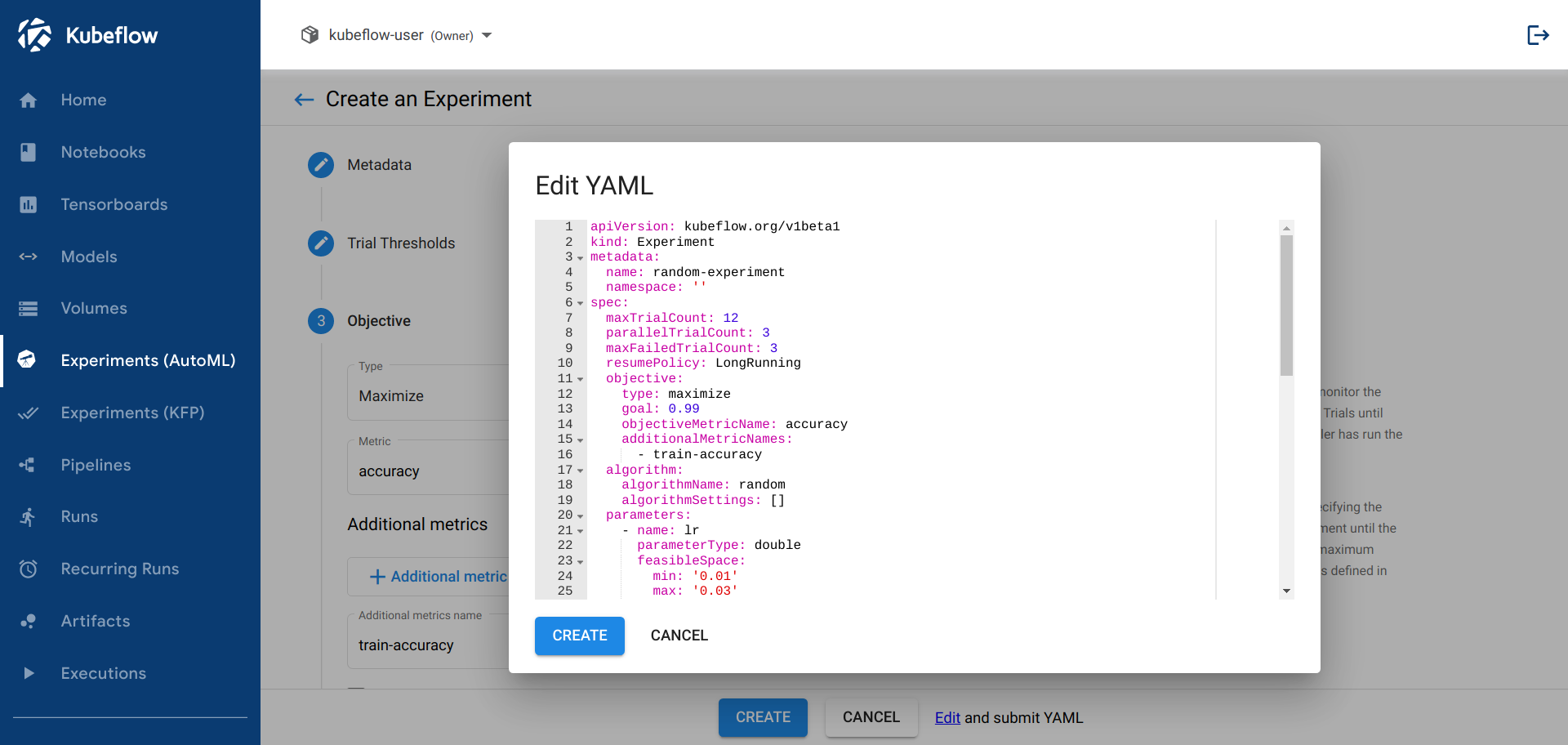
-
Parameters: Choose this option to enter the configuration values into a form.
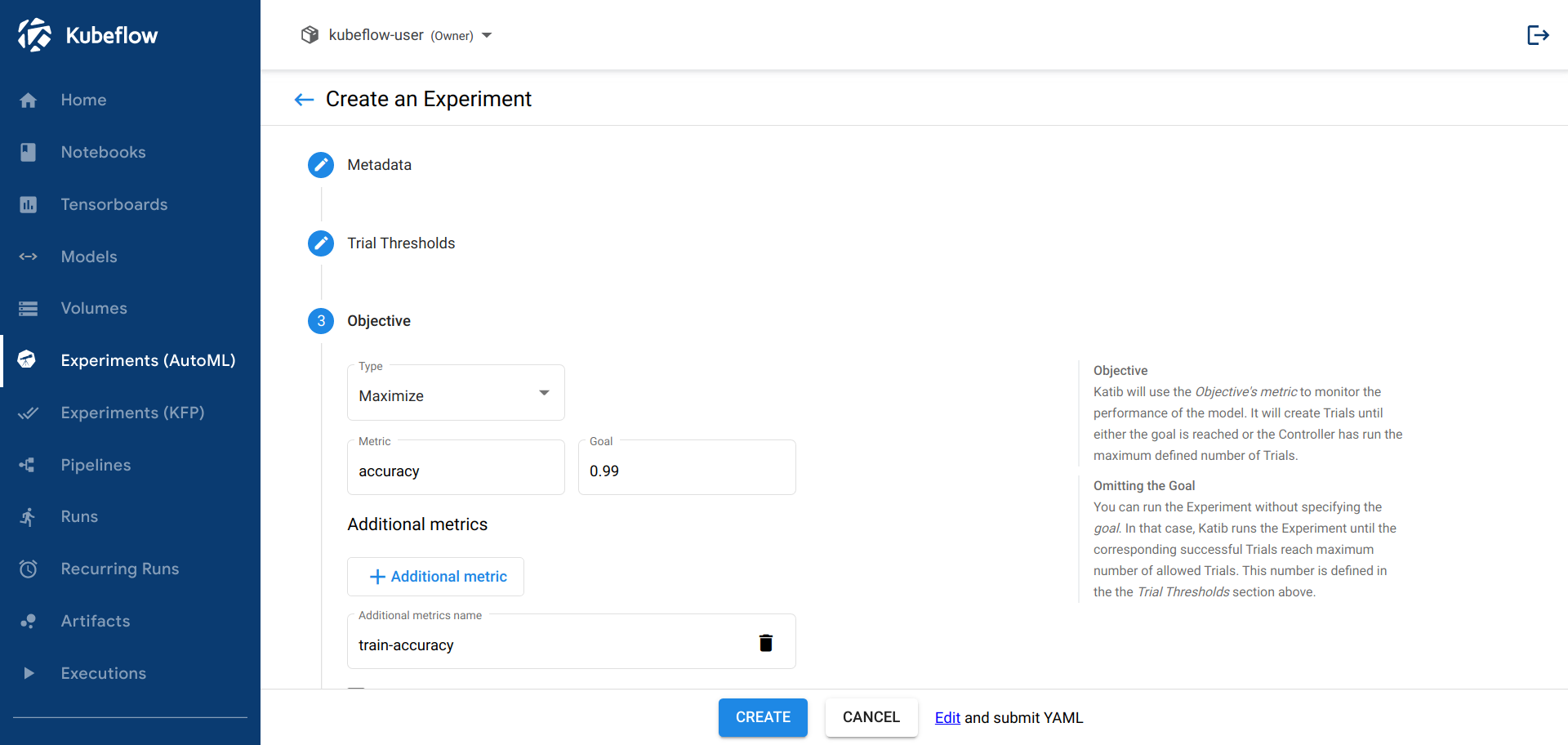
-
View the results of the experiment in the Katib UI:
-
You should be able to view the list of experiments:
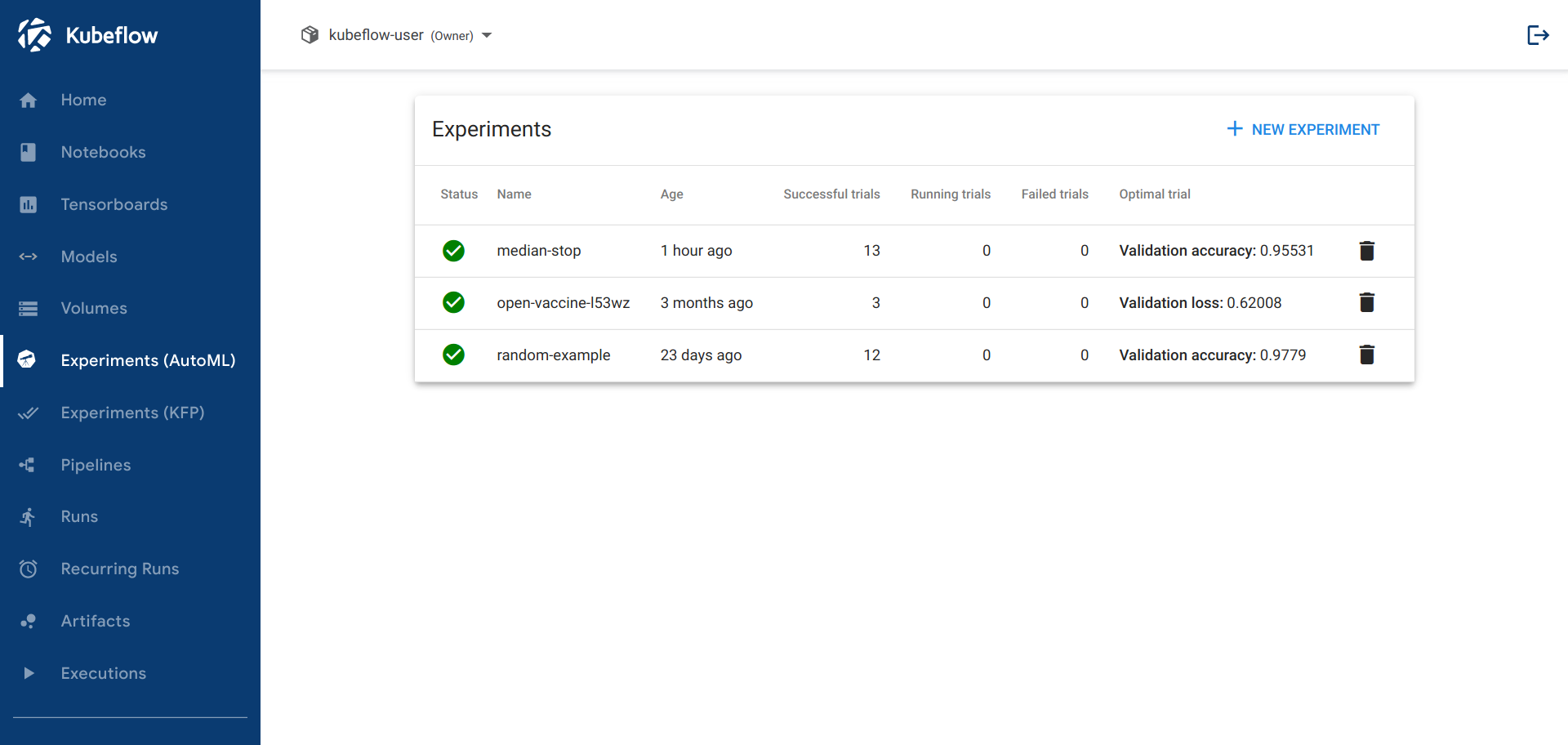
-
Click the name of your experiment. For example, click random-example.
-
There should be a graph showing the level of validation and train accuracy for various combinations of the hyperparameter values (learning rate, number of layers, and optimizer):
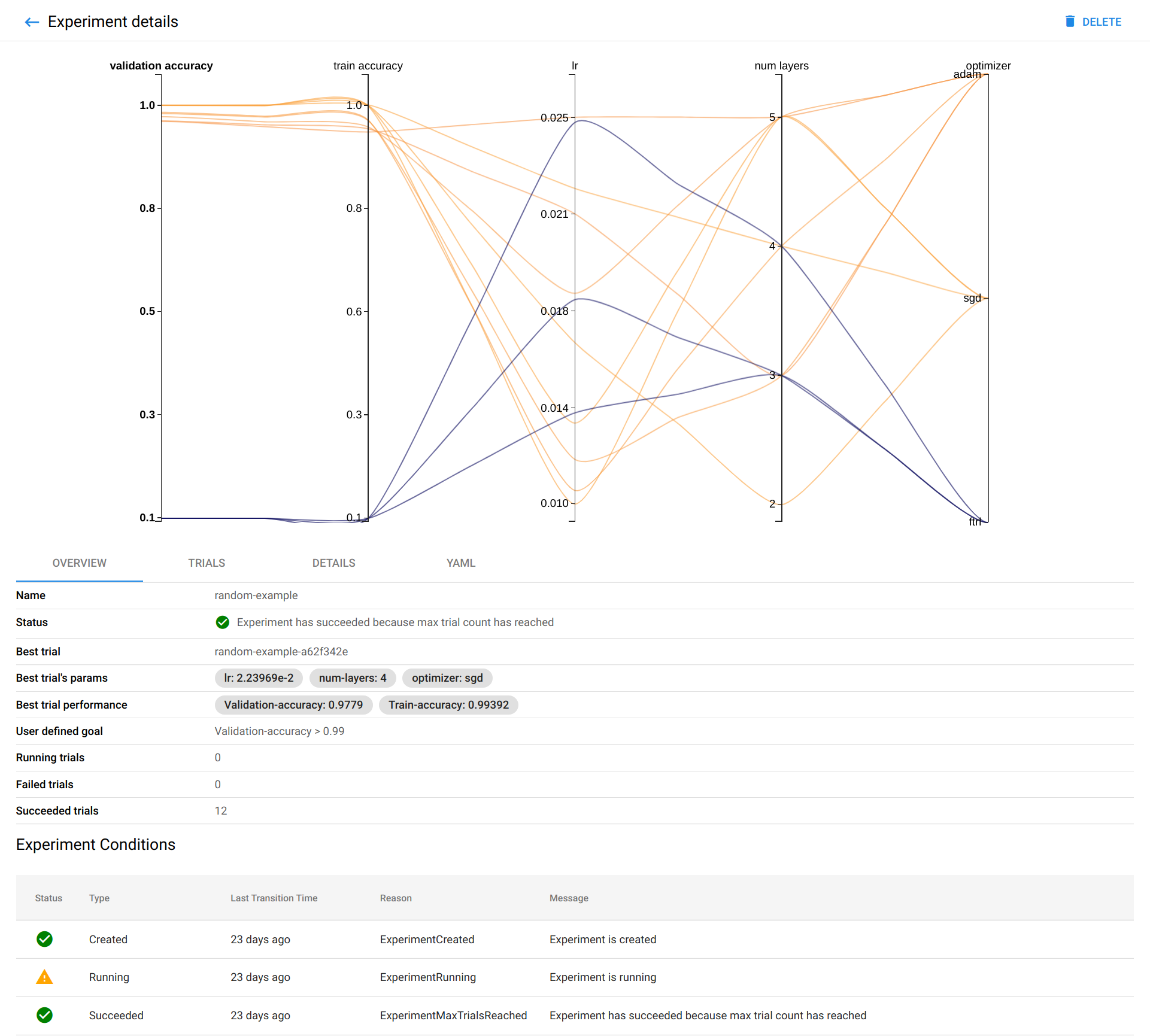
-
Below the graph is a list of trials that ran within the experiment:
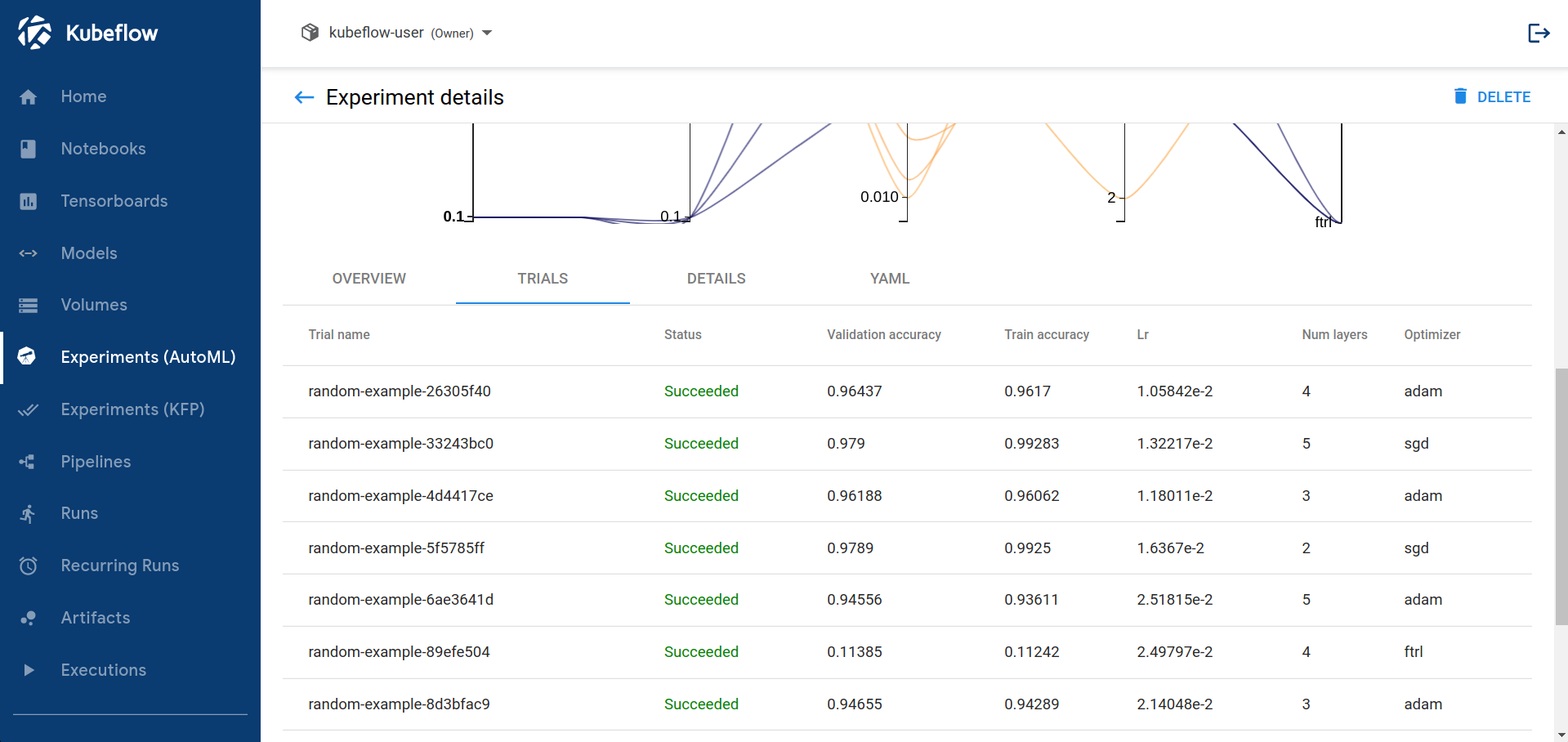
-
You can click on trial name to get metrics for the particular trial:
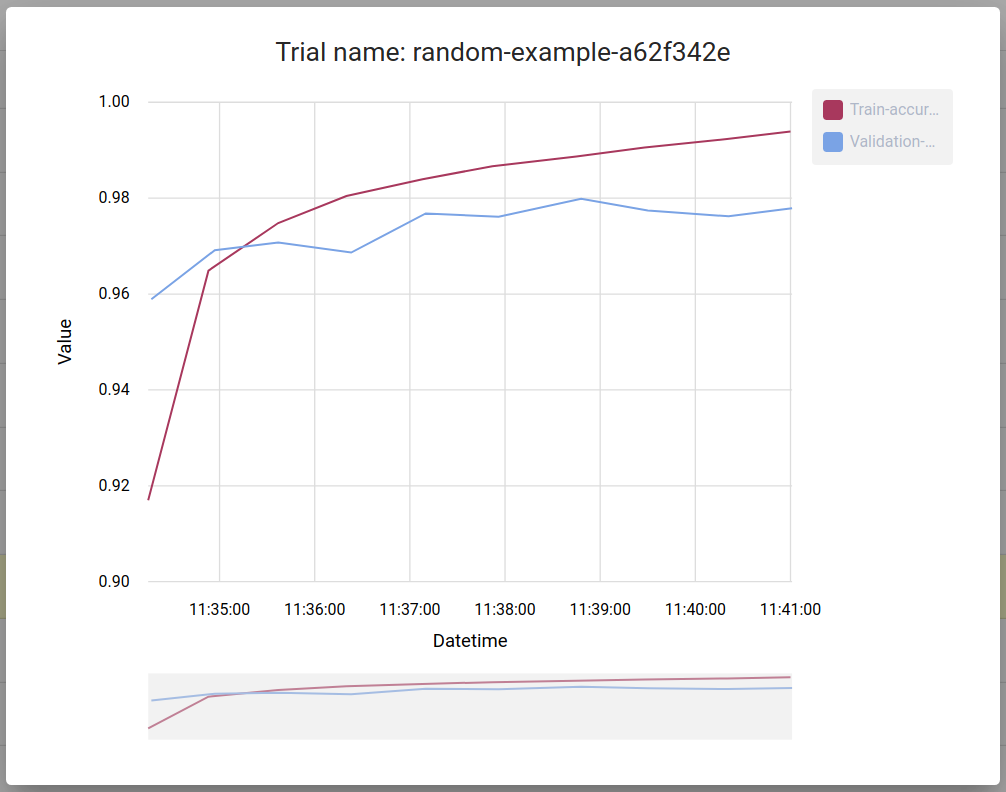
Next steps
-
Learn how to run the random search algorithm and other Katib examples.
-
Learn to configure your trial templates.
-
For an overview of the concepts involved in hyperparameter tuning and neural architecture search, check the introduction to Katib.
-
Boost your hyperparameter tuning experiment with the early stopping guide
-
Check the Katib Configuration (Katib config).
-
How to set up environment variables for each Katib component.
Feedback
Was this page helpful?
Glad to hear it! Please tell us how we can improve.
Sorry to hear that. Please tell us how we can improve.